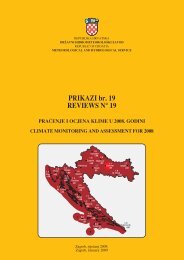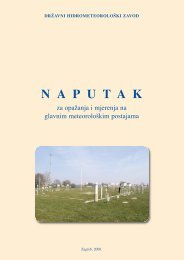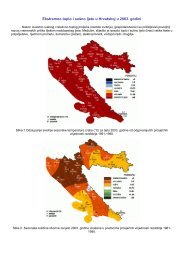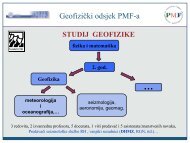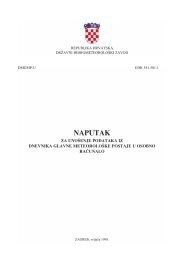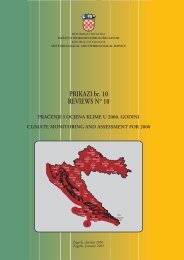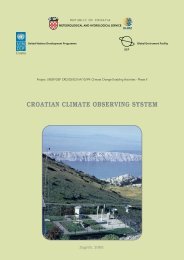Observed climate changes in Croatia Climate change scenario
Observed climate changes in Croatia Climate change scenario
Observed climate changes in Croatia Climate change scenario
Create successful ePaper yourself
Turn your PDF publications into a flip-book with our unique Google optimized e-Paper software.
2. <strong>Climate</strong> Change Scenario<br />
2.1. Introduction<br />
2.1.1 General remarks<br />
Information on global <strong>climate</strong> <strong>change</strong> of the mean value of some climatological<br />
parameter, temperature for example, is not sufficient to estimate <strong>climate</strong> <strong>change</strong> at regional or<br />
local level. The <strong>in</strong>tensity of local <strong>climate</strong> <strong>change</strong> can differ from the <strong>change</strong> of global mean value<br />
because of specific latitude, topographic features, distribution of land and sea, etc. However,<br />
local <strong>climate</strong> <strong>change</strong> should be viewed with<strong>in</strong> the context of global <strong>change</strong> modulated by local<br />
impacts. In this report the results of dynamical downscal<strong>in</strong>g by a regional <strong>climate</strong> model for the<br />
two 30-year periods are described and discussed – for the <strong>climate</strong> of the 20 th century and the<br />
future <strong>climate</strong> from the 21 st century, accord<strong>in</strong>g to the A2 <strong>scenario</strong> of Intergovernmental Panel on<br />
<strong>Climate</strong> Change (IPCC).<br />
Dynamical downscal<strong>in</strong>g is the method that adjusts the output of a global <strong>climate</strong> model to<br />
a smaller area by the help of a regional <strong>climate</strong> model. Thus, the results of <strong>climate</strong> <strong>change</strong> at a<br />
relatively coarse resolution (200-300 km) are be<strong>in</strong>g adjusted to much f<strong>in</strong>er space resolution (20-<br />
50 km). In this process a regional model def<strong>in</strong>es its “own” hydro- and thermo-dynamical<br />
processes at smaller scales, adjust<strong>in</strong>g to the boundary forc<strong>in</strong>g from a global model. In such a<br />
way, dynamical consistency <strong>in</strong> the modelled atmosphere is be<strong>in</strong>g achieved. Space variations of<br />
<strong>climate</strong> parameters are better represented at smaller scales by dynamical downscal<strong>in</strong>g,<br />
especially extreme events, whose <strong>in</strong>tensity <strong>in</strong> global models is usually weakened as the smallest<br />
grid box of few hundred kilometres can cover the whole region of <strong>in</strong>terest. The alternatives to<br />
dynamical downscal<strong>in</strong>g are statistical downscal<strong>in</strong>g methods, but they do not take <strong>in</strong>to account<br />
the dynamical connection between global and regional scales.<br />
Although def<strong>in</strong>ed for smaller areas and f<strong>in</strong>er resolution, regional <strong>climate</strong> models cannot<br />
improve possible poor results of global models. Of course, vice versa is valid as well –<br />
dynamical downscal<strong>in</strong>g by a poor regional <strong>climate</strong> model cannot improve the global model<br />
simulation regardless of the resolution improvement. In other words, the quality of dynamical<br />
downscal<strong>in</strong>g results depends on the quality of regional model used for dynamical downscal<strong>in</strong>g<br />
as well as on the quality of global model results.<br />
It should be po<strong>in</strong>ted out that the results of a regional <strong>climate</strong> model cannot accurately<br />
describe observational data at regional (local) scale. Of course, it is important that the difference<br />
between model results and observations would be as small as possible, but, as model offers<br />
only approximation of the actual situation, it <strong>in</strong>evitably conta<strong>in</strong>s errors. Accord<strong>in</strong>gly, a good<br />
model is the one with relatively small (systematic) errors. After compar<strong>in</strong>g the model results with<br />
18




